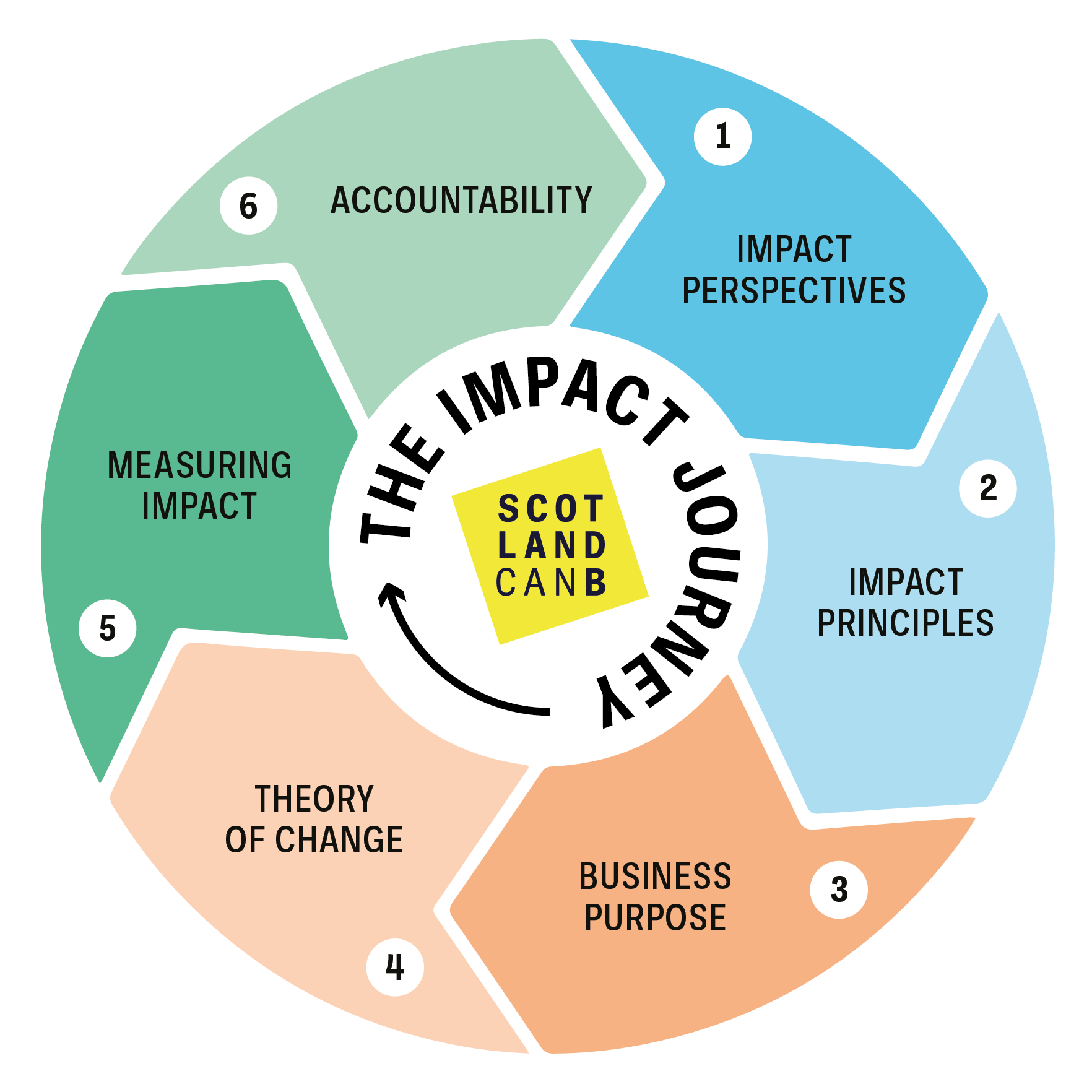
Introducing: The Impact Journey
A business impact methodology for the nation
The Impact Journey is Scotland’s government-backed methodology designed to support any Scottish business, regardless of size, stage, or sector, to understand, measure, and manage their environmental, social, and governance performance.
At Scotland CAN B, we embrace the idea that for organisations to truly adopt the mentality of ‘impact’ requires them to go on a journey of discovery. This is what gave rise to the development of the Impact Journey.
The Impact Journey is a robust, adaptable, and holistic 6-module learning journey which helps businesses to idenitfy and track their impact comprehensively across all areas and stakeholders and towards national and global frameworks.
It is designed as a circular process which can be used as the basis for ongoing improvement for years to come, and leverages pre-existing cutting-edge tools and frameworks including those from B Lab and the B Corp movement.
The Impact Journey content is updated annually in line with the latest best practice, and the emergent nature of this field of work.
A Journey underpinned by three key Principles…
‘Interdependence’
Everything is connected. Businesses are embedded within and interdependent with society and the planet. At Scotland CAN B we are committed to fostering a mindset and an approach to business which acts on the understanding that people and place matter, and that we have a responsibility for each other and future generations.
‘Stakeholder’
A ‘stakeholder’ is any entity (person, group, place, or otherwise) which can impact or be impacted by an organisation’s actions, objectives and policies. It’s worth keeping in mind that some stakeholders might be more obvious, visible, or demanding than others, but that doesn’t necessarily mean they are more important.
‘Impact’
We define ‘impact’ as the touchpoint between your actions and the world around you. There are many levels of impact, and it’s important to remember that each choice or action we take can have far reaching impact beyond our immediate experience; intended or unintended, positive and negative.
… and guided by five impact areas & stakeholder groups
Drawn from the B Impact Assessment, and our heritage in the B Corp movement
Supporting businesses to understand their contributions towards national and global frameworks
The Impact Journey helps businesses understand and engage in their unique and vital contributions towards realising national and global wellbeing & sustainable development targets – Scotland's National Performance Framework & the Global Sustainable Development Goals.
Creating coherence out of complexity
Businesses, and their advisors for that matter, can often feel pulled in different directions by what is sometimes described as a ‘cluttered’ landscape of competing demands and priorities.
In designing the Impact Journey, we’ve sought to take care of navigating this complexity on your behalf and woven social, environmental, and economic policy priorities all into one streamlined and easy-to-follow framework, relevant to every Scottish business.
Why did we create the Impact Journey? and Why now?
The Impact Journey was created to transform the way we do business, so that every single business in Scotland, whether big or small, is fully equipped to better understand, be held accountable for, and improve its social and environmental impact.
The Big Picture
“The living world is a unique and spectacular marvel, (but) the way we, humans, live on Earth, is sending it into a decline…” – David Attenborough
The climate and ecological emergencies and social inequality and injustices are profound and urgent problems that can only be solved if we harness the enormous potential of entrepreneurs, innovation, and enterprise.
We created the Impact Journey as a practical mechanism to harness this potential, in a way which is comprehensive, coherent, and accountable.
The License to operate
Customers are demanding transparency from the brands they buy from. Employees want to be values-aligned with their place of work. Communities are looking to businesses to step up and help solve local problems. Investors want to minimize their exposure to the risks of an uncertain future. Governments are looking to embed business accountability into law.
Getting ahead of the curve now, and nurturing impact management capabilities increasingly offers a distinct and compelling competitive advantage.
The Business Benefits
Better understanding your impact, positive or negative, enables better-informed decisions for investment, innovation, skills development, talent attraction and retention, procurement, grant and award applications, and much more.
Impact and Purpose needn’t be seen as just another demand and burden on your business, but instead as a powerful lens of exploration and superpower to help your organisation grow and succeed as future fit, better businesses, by every measure.
Explore the Impact Journey modules
The Impact Journey is a holistic methodology and framework which is designed to balance the wider need to catalyse a fundamental business mindset shift and foster Impact Culture, alongside helping businesses and advisors get equipped with the practical tools, skills, and capabilities needed to implement impact management best practices.
The content of the Journey links to our Theory of Change and 4 Goals to leverage the role of business towards economic systems change.
-
Let’s zoom out to remember where we are in time and space. We look at the ecological, social, and economic systems and context we operate within, and the evolving role of business as an agent for systems change. We encounter the SDGs, National Performance Framework & Doughnut Economics as frameworks for impact.
Learning Objectives:Understand the relationship between impact and business.
Gain new perspectives on how your business impacts different contexts.
Walk away with a familiarity of the SDGs, NPF, and Doughnut Economics frameworks.
-
Discover the core principles, which allow us to consider with fresh eyes the potential impact that our organisations are responsible for, whether or not we quantify it. We can begin to see the variety of ways in which we can shape our businesses towards becoming a force for good.
Learning Objectives:
Understand the three key principles: interdependence, stakeholder, and impact.
Begin to identify opportunities for impact across 5 impact areas and stakeholder groups.
Link your business to national and global sustainable development frameworks.
Explore the benefits of short term vs long term thinking.
-
It’s time to drill down and get more specific. Explore how to engage with business “purpose” and the change your business is at the heart of making, for better or worse, intended or unintended. Learn how each business can embody impact business models.
Learning Objectives:
Connect with this idea of purpose and begin to understand how it can show up in a business
Understand the concept of an impact business model and which stakeholders a business model could affect
Learn how the 3 Horizons framework can help a business reflect on the role they have to play
-
Learn how to define your theory of change and desired long term outcomes for your stakeholders, in order to define outputs and key performance indicators for your organisation.
Learning Objectives:
Explain the difference between an output and an outcome
Defining a theory of change
Short and long term desired outcomes for stakeholders
-
A review of impact measurement tools including the B Impact Assessment (BIA), SDG Action Manager, SROI and Future Fit. Learn about the credibility, limitations, and benefits of using tools to comprehensively measure business impact performance, and which ones may be useful for different businesses at different times.
Learning Objectives:
Be able to identify main impact tools available for businesses
Explain three necessary starting points as it relates to measuring impact
Understand the different types of data/information that can be collected
Understand different methods used to gather the information/data needed to measure impact
-
Make meaning of impact measurement efforts and learn ways that you can improve and manage impact. Discover how comprehensive impact reporting can inform future opportunities, and businesses can use transparency and responsibility to their advantage.
Learning Objectives:
Understand how to make sense of impact measurement results
Learn ways to share impact measurement results with others and report on it
Identify opportunities for impact improvement
What people are saying about the Impact Journey:
“The Impact Journey supports our goal of ingraining meaningful inclusive economic growth across our business communities, providing a means of driving greater social impact through our mainstream business practices”
— Darah Zahran, Scottish Enterprise
“I now feel that my knowledge has been pulled together into a more coherent narrative and supported with practical tools to do something about it.”
—Business Advisor
"The course has been vital to my business and opened up new ideas, new models and how to implement and measure ‘impact’ within my own sector."


















